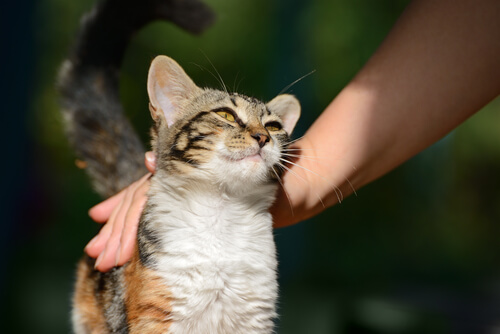How to Train your Cat

Learning to train your cat isn’t impossible, even though at times it may seem like it. The secret to success when it comes to training kitty is to find a way to convince him that he wants to cooperate. He needs to understand that there is a “deal”, that there’s something in it for him.
With that in mind, you should know that “making a deal” in this context means that traditional disciplinary methods should be completely discarded. Cats don’t learn through punishment or “discipline.” Furthermore, punishing them could stress them out and lead to health and behavioral problems.
Don’t forget, patience and positive reinforcement are essential when you try to train your cat.
3 keys to train your cat
As we said at the beginning, the trick to training your cat is to motivate him to win a prize. What you’ll be doing is to try and convince him that coming to you when you call is time well spent.
It may seem difficult, but reward-based training also works for cats. What might be a little more complicated is to find what truly motivates a cat to obey. Which reward should you use to convince him to sacrifice his stubbornness?
Finding out what truly motivates your cat
Each cat has that “something” that will motivate him to do whatever you ask. Edible treats are the usual thing. Some kind of cheese, perhaps. Or sausage, ham, tuna, chicken, pate, liver…

Reward the cat
You don’t just have to find out what drives your cat crazy. You should also offer the treat when your fluffy friend does as he’s told. Basically, when the cat “seals the deal”.
Not only that, but you also have to give out the treats in small quantities, just enough for the cat to taste them. You need to encourage him to come back for more. The cat will lose motivation if his desire is totally fulfilled. If you leave him yearning for more, then he’ll strive to achieve it.
If you don’t know what your cat is crazy about, then find out. Just offer him different pieces of different foods until you find out what he loves.
Use a clicker
A clicker is a small plastic device that emits a sound, a “click,” when you press it. The idea is to get the cat to connect the sound to the prize. This training is called operant conditioning.
Reinforcing this kind of conditioning is very simple. You leave a prize on the floor and, when the cat eats it, you press the clicker. After that, repeat it several times. Very soon the cat will look at the ground eagerly when you press on the clicker. As soon as this happens you’ll know the cat’s ready for training.
Keep in mind that, without the clicker, the cat may not be sure why he’s receiving his reward. When the feline obeys an order, hears the ‘click’, and then receives a prize, he’ll figure out the nature of the deal more easily.

Time and patience
Cats learn at their own pace. This means that you should repeat training exercises for several days or weeks. They should be done several times a day, for short periods of time. Consistency and repetition are fundamental.
If you leave it for a few days, the cat will forget what he learned. However, if the training sessions are too long, he’ll get bored and lose interest.
When the cat is ready
As soon as your cat learns to respond to the clicker signal, then he’s ready to learn to obey. Yes, cats can learn to respond to vocal signals. This step to train your cat begins by making a different sound before you feed him. You could open a bag or a can, and then call the cat or make a clicking sound with your tongue. The feline will learn to associate that sound with something positive (food), and it will come to you shortly after.
As soon as you notice that the cat has understood, you should reinforce what he has learned outside of his regular feeding times. Begin to do so from a short distance. Make the sound, use the clicker when the cat comes, and then reward him with a prize. When the training begins to work, call the cat from further away and start training him little by little so that he learns to obey other orders.

Learning to train your cat isn’t impossible, even though at times it may seem like it. The secret to success when it comes to training kitty is to find a way to convince him that he wants to cooperate. He needs to understand that there is a “deal”, that there’s something in it for him.
With that in mind, you should know that “making a deal” in this context means that traditional disciplinary methods should be completely discarded. Cats don’t learn through punishment or “discipline.” Furthermore, punishing them could stress them out and lead to health and behavioral problems.
Don’t forget, patience and positive reinforcement are essential when you try to train your cat.
3 keys to train your cat
As we said at the beginning, the trick to training your cat is to motivate him to win a prize. What you’ll be doing is to try and convince him that coming to you when you call is time well spent.
It may seem difficult, but reward-based training also works for cats. What might be a little more complicated is to find what truly motivates a cat to obey. Which reward should you use to convince him to sacrifice his stubbornness?
Finding out what truly motivates your cat
Each cat has that “something” that will motivate him to do whatever you ask. Edible treats are the usual thing. Some kind of cheese, perhaps. Or sausage, ham, tuna, chicken, pate, liver…

Reward the cat
You don’t just have to find out what drives your cat crazy. You should also offer the treat when your fluffy friend does as he’s told. Basically, when the cat “seals the deal”.
Not only that, but you also have to give out the treats in small quantities, just enough for the cat to taste them. You need to encourage him to come back for more. The cat will lose motivation if his desire is totally fulfilled. If you leave him yearning for more, then he’ll strive to achieve it.
If you don’t know what your cat is crazy about, then find out. Just offer him different pieces of different foods until you find out what he loves.
Use a clicker
A clicker is a small plastic device that emits a sound, a “click,” when you press it. The idea is to get the cat to connect the sound to the prize. This training is called operant conditioning.
Reinforcing this kind of conditioning is very simple. You leave a prize on the floor and, when the cat eats it, you press the clicker. After that, repeat it several times. Very soon the cat will look at the ground eagerly when you press on the clicker. As soon as this happens you’ll know the cat’s ready for training.
Keep in mind that, without the clicker, the cat may not be sure why he’s receiving his reward. When the feline obeys an order, hears the ‘click’, and then receives a prize, he’ll figure out the nature of the deal more easily.

Time and patience
Cats learn at their own pace. This means that you should repeat training exercises for several days or weeks. They should be done several times a day, for short periods of time. Consistency and repetition are fundamental.
If you leave it for a few days, the cat will forget what he learned. However, if the training sessions are too long, he’ll get bored and lose interest.
When the cat is ready
As soon as your cat learns to respond to the clicker signal, then he’s ready to learn to obey. Yes, cats can learn to respond to vocal signals. This step to train your cat begins by making a different sound before you feed him. You could open a bag or a can, and then call the cat or make a clicking sound with your tongue. The feline will learn to associate that sound with something positive (food), and it will come to you shortly after.
As soon as you notice that the cat has understood, you should reinforce what he has learned outside of his regular feeding times. Begin to do so from a short distance. Make the sound, use the clicker when the cat comes, and then reward him with a prize. When the training begins to work, call the cat from further away and start training him little by little so that he learns to obey other orders.

All cited sources were thoroughly reviewed by our team to ensure their quality, reliability, currency, and validity. The bibliography of this article was considered reliable and of academic or scientific accuracy.
This text is provided for informational purposes only and does not replace consultation with a professional. If in doubt, consult your specialist.








